LeBron James theme by Frank Skalka
Download: LeBronJames_2.p3t
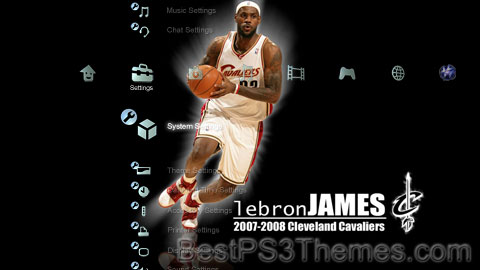
(9 backgrounds)
LeBron Raymone James Sr. (/ləˈbrɒn/ lə-BRON; born December 30, 1984) is an American professional basketball player for the Los Angeles Lakers of the National Basketball Association (NBA). Nicknamed "King James", he is widely recognized as one of the greatest players in the history of the sport and is often compared to Michael Jordan in debates regarding who is the greatest basketball player of all time.[a] He has competed in 10 NBA Finals (with eight consecutive appearances from 2011 to 2018), winning four NBA championships.[1] He also won the inaugural NBA Cup in 2023 with the Lakers, and two Olympic gold medals as a member of the U.S. men's national team.
Individually, James is the all-time leading scorer in NBA history and ranks fourth in career assists, has won four Most Valuable Player (MVP) Awards, four Finals MVP Awards, three All-Star Game MVP Awards, and was named the inaugural NBA Cup MVP. He has been named an All-Star a record 20 times, selected to the All-NBA Team 20 times (including 13 First Team selections)[2][3] and the All-Defensive Team six times, and was a runner-up for the NBA Defensive Player of the Year Award twice in his career.[4][5] Noted for his longevity, James is currently the oldest player in the NBA.[6] After his son Bronny was drafted in 2024, he became part of the first active father-son duo in NBA history.
James grew up playing basketball for St. Vincent–St. Mary High School in his hometown of Akron, Ohio. He was heavily touted by the national media as a future NBA superstar for his all-around scoring, passing, athleticism and playmaking abilities.[7] A prep-to-pro, he was selected by the Cleveland Cavaliers with the first overall pick of the 2003 NBA draft. Named the 2004 NBA Rookie of the Year,[8] he soon established himself as one of the league's premier players, leading the Cavaliers to their first NBA Finals appearance in 2007 and winning the NBA MVP award in 2009 and 2010.[4] After failing to win a championship with Cleveland, James left in 2010 as a free agent to join the Miami Heat;[9] this was announced in a nationally televised special titled The Decision and is among the most controversial free agency moves in sports history.[10]
James won his first two NBA championships while playing for the Heat in 2012 and 2013; in both of these years, he also earned the league's MVP and Finals MVP awards. After his fourth season with the Heat in 2014, James opted out of his contract and re-signed with the Cavaliers. In 2016, he led the Cavaliers to victory over the Golden State Warriors in the Finals by coming back from a 3–1 deficit, delivering the team's first championship and ending the Cleveland sports curse.[11] In 2018, James exercised his contract option to leave the Cavaliers and signed with the Lakers, where he won the 2020 NBA championship and his fourth Finals MVP.[12] On February 7, 2023, James surpassed Kareem Abdul-Jabbar to become the leading scorer in league history.
Off the court, James has earned more wealth and fame from numerous endorsement contracts. He is the first player in NBA history to accumulate $1 billion in earnings as an active player.[13] He has been featured in books, documentaries (including winning three Sports Emmy Awards as an executive producer), and television commercials. James was among Time's 100 most influential people in the world in 2005, 2013, 2017, and 2019, the most selections by a professional athlete. He has won 20 ESPY Awards, hosted Saturday Night Live, and starred in the sports film Space Jam: A New Legacy (2021). James has been a part-owner of Liverpool F.C. since 2011 and leads the LeBron James Family Foundation, which has opened an elementary school, housing complex, retail plaza, and medical center in Akron.[14][15]
Early life[edit]
James was born on December 30, 1984, in Akron, Ohio, to Gloria Marie James, who was 16 at the time of his birth.[16]: 22 His father, Anthony McClelland, has an extensive criminal record and was not involved in his life.[17][18][19] When James was growing up, life was often a struggle for the family, as they moved from apartment to apartment in the seedier neighborhoods of Akron while Gloria struggled to find steady work.[20] Realizing that her son would be better off in a more stable family environment, Gloria allowed him to move in with the family of Frank Walker, a local youth football coach who introduced James to basketball when he was nine years old.[16]: 23
James began playing organized basketball in the fifth grade.[21] He later played Amateur Athletic Union (AAU) basketball for the Northeast Ohio Shooting Stars.[20] The team enjoyed success on a local and national level, led by James and his friends Sian Cotton, Dru Joyce III, and Willie McGee.[16]: 24 The group dubbed themselves the "Fab Four" and promised each other that they would attend high school together.[16]: 27 In a move that stirred local controversy, they chose to attend St. Vincent–St. Mary High School, a private Catholic school with predominantly white students.[22]
High school career[edit]
Basketball[edit]
As a 6-foot-2-inch (1.88 m) tall freshman, James averaged 21 points and 6 rebounds per game for the St. Vincent–St. Mary varsity basketball team.[23] The Fighting Irish went 27–0 en route to the Division III state title, making them the only boys high school team in Ohio to finish the season undefeated.[24] As a sophomore, James averaged 25.2 points and 7.2 rebounds, along with 5.8 assists and 3.8 steals per game.[25] For some home games during the season, St. Vincent–St. Mary played at the University of Akron's 5,492-seat Rhodes Arena to satisfy ticket demand from alumni, fans, as well as college and NBA scouts who wanted to see James play.[26] The Fighting Irish finished the season 26–1 and repeated as state champions.[23] For his outstanding play, James was named Ohio Mr. Basketball and selected to the USA Today All-USA First Team, becoming the first sophomore to do either.[23]
In 2001, during the summer before his junior year, James was the subject of a feature article in Slam magazine in which writer Ryan Jones lauded the 16-year-old James, who had grown to 6 feet 7 inches (2.01 m), as "[possibly] the best high school basketball player in America right now".[27] During the season, James also appeared on the cover of Sports Illustrated, becoming the first high school basketball underclassman to do so.[16]: 104 With averages of 29 points, 8.3 rebounds, 5.7 assists, and 3.3 steals per game, he was again named Ohio Mr. Basketball and selected to the USA Today All-USA First Team,[23] and became the first junior to be named male basketball Gatorade National Player of the Year.[16]: 117 St. Vincent–St. Mary finished the year with a 23–4 record, ending their season with a loss in the Division II championship game.[16]: 114 Following the loss, James unsuccessfully petitioned for a change to the NBA's draft eligibility rules in an attempt to enter the 2002 NBA draft.[28][29] During this time, he used marijuana, which he said was to help cope with the stress that resulted from the constant media attention he was receiving.[30]
Throughout his senior year, James and the Fighting Irish traveled across the country to play a number of nationally ranked teams, including a game on December 12, 2002, against Oak Hill Academy that was nationally televised on ESPN2.[16]: 142 Time Warner Cable, looking to capitalize on James's popularity, offered St. Vincent–St. Mary's games to Ohio-based subscribers for $7.95 per game on a pay-per-view basis throughout the season, but ended up not being profitable.[16]: 143 [31] For the year, James averaged 31.6 points, 9.6 rebounds, 4.6 assists, and 3.4 steals per game,[23] was named Ohio Mr. Basketball and selected to the USA Today All-USA First Team for an unprecedented third consecutive year,[16]: 178 and was named Gatorade National Player of the Year for the second consecutive year.[23] He participated in three year-end high school basketball all-star games—the EA Sports Roundball Classic, the Jordan Brand Capital Classic, and the McDonald's All-American Game—losing his National Collegiate Athletic Association (NCAA) eligibility and making it official that he would enter the 2003 NBA draft.[32]
Also during his senior year, James was the centerpiece of several controversies. For his 18th birthday, he skirted state amateur bylaws by accepting a Hummer H2 as a gift from his mother, who had secured a loan for the vehicle by utilizing James's future earning power as an NBA player.[33] This prompted an investigation by the Ohio High School Athletic Association (OHSAA) because its guidelines stated that no amateur may accept any gift valued over $100 as a reward for athletic performance. James was cleared of any wrongdoing because he had accepted the luxury vehicle from a family member and not from an agent or any outside source.[32] Later in the season, James accepted two throwback jerseys worth $845 from an urban clothing store in exchange for posing for pictures, officially violating OHSAA rules and resulting in his being stripped of his high school sports eligibility.[32] James appealed the ruling and his penalty was eventually dropped to a two-game suspension, allowing him to play the remainder of the year. The Irish were also forced to forfeit one of their wins, their only official loss that season.[34] In his first game back after the suspension, James scored a career-high 52 points.[35] St. Vincent–St. Mary went on to win the Division II championship, marking their third division title in four years.[36]
Football[edit]
As an underclassman, James played wide receiver for St. Vincent–St. Mary's football team.[16]: 51 He was recruited by some Division I programs, including Notre Dame.[37] At the conclusion of his second year, he was named first team all-state, and as a junior, he helped lead the Fighting Irish to the state semifinals.[25] He did not play during his senior year because of a wrist injury that he sustained in an AAU basketball game.[38] Some sports analysts, football critics, high school coaches, former and current players have speculated that James could have played in the National Football League.[b]
Professional career[edit]
Cleveland Cavaliers (2003–2010)[edit]
2003–2004: Rookie of the Year[edit]

James was selected by his hometown team, the Cleveland Cavaliers, as the first overall pick of the 2003 NBA draft.[43] In his first regular season game, he scored 25 points in a 106–92 loss to the Sacramento Kings, setting an NBA record for the most points scored by a prep-to-pro player in his debut performance.[44] At the conclusion of the 2003–2004 season, he became the first Cavalier to receive the NBA Rookie of the Year Award.[8] With final averages of 20.9 points, 5.5 rebounds, and 5.9 assists per game,[45] he also became the third player in league history to average at least 20 points, 5 rebounds, and 5 assists per game as a rookie.[46] Cleveland ultimately finished the season 35–47, failing to make the playoffs despite an 18-game improvement over the previous year.[47]
2004–2008: Rise to superstardom[edit]
In the 2004–2005 season, James earned his first NBA All-Star Game selection, contributing 13 points, 8 rebounds, and 6 assists in a winning effort for the Eastern Conference.[48] Around the league, teams took note of his rapid development, and Denver Nuggets coach George Karl told Sports Illustrated: "It's weird talking about a 20-year-old kid being a great player, but he is a great player ... He's the exception to almost every rule."[49] On March 20, James scored 56 points against the Toronto Raptors, setting Cleveland's new single-game points record.[50] With final averages of 27.2 points, 7.4 rebounds, 7.2 assists, and 2.2 steals per game, he was named to his first All-NBA Team.[25] Despite a 30–20 record to start the year,[50] the Cavaliers again failed to make the playoffs, finishing the season 42–40.[51]
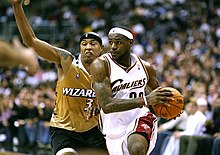
At the
Old School theme by nick48 Download: OldSchool.p3t Redirect to: Iron Man Alternative theme by jpang Download: IronManAlt.p3t P3T Unpacker v0.12 This program unpacks Playstation 3 Theme files (.p3t) so that you can touch-up an existing theme to your likings or use a certain wallpaper from it (as many themes have multiple). But remember, if you use content from another theme and release it, be sure to give credit! Download for Windows: p3textractor.zip Instructions: Download p3textractor.zip from above. Extract the files to a folder with a program such as WinZip or WinRAR. Now there are multiple ways to extract the theme. The first way is to simply open the p3t file with p3textractor.exe. If you don’t know how to do this, right click the p3t file and select Open With. Alternatively, open the p3t file and it will ask you to select a program to open with. Click Browse and find p3textractor.exe from where you previously extracted it to. It will open CMD and extract the theme to extracted.[filename]. After that, all you need to do for any future p3t files is open them and it will extract. The second way is very simple. Just drag the p3t file to p3textractor.exe. It will open CMD and extract the theme to extracted.[filename]. For the third way, first put the p3t file you want to extract into the same folder as p3textractor.exe. Open CMD and browse to the folder with p3extractor.exe. Enter the following: Iron Man Alternative (Standard Icons) theme by jpang Download: IronManAltStandard.p3t P3T Unpacker v0.12 This program unpacks Playstation 3 Theme files (.p3t) so that you can touch-up an existing theme to your likings or use a certain wallpaper from it (as many themes have multiple). But remember, if you use content from another theme and release it, be sure to give credit! Download for Windows: p3textractor.zip Instructions: Download p3textractor.zip from above. Extract the files to a folder with a program such as WinZip or WinRAR. Now there are multiple ways to extract the theme. The first way is to simply open the p3t file with p3textractor.exe. If you don’t know how to do this, right click the p3t file and select Open With. Alternatively, open the p3t file and it will ask you to select a program to open with. Click Browse and find p3textractor.exe from where you previously extracted it to. It will open CMD and extract the theme to extracted.[filename]. After that, all you need to do for any future p3t files is open them and it will extract. The second way is very simple. Just drag the p3t file to p3textractor.exe. It will open CMD and extract the theme to extracted.[filename]. For the third way, first put the p3t file you want to extract into the same folder as p3textractor.exe. Open CMD and browse to the folder with p3extractor.exe. Enter the following: WinMac theme by unknown Download: WinMac.p3t P3T Unpacker v0.12 This program unpacks Playstation 3 Theme files (.p3t) so that you can touch-up an existing theme to your likings or use a certain wallpaper from it (as many themes have multiple). But remember, if you use content from another theme and release it, be sure to give credit! Download for Windows: p3textractor.zip Instructions: Download p3textractor.zip from above. Extract the files to a folder with a program such as WinZip or WinRAR. Now there are multiple ways to extract the theme. The first way is to simply open the p3t file with p3textractor.exe. If you don’t know how to do this, right click the p3t file and select Open With. Alternatively, open the p3t file and it will ask you to select a program to open with. Click Browse and find p3textractor.exe from where you previously extracted it to. It will open CMD and extract the theme to extracted.[filename]. After that, all you need to do for any future p3t files is open them and it will extract. The second way is very simple. Just drag the p3t file to p3textractor.exe. It will open CMD and extract the theme to extracted.[filename]. For the third way, first put the p3t file you want to extract into the same folder as p3textractor.exe. Open CMD and browse to the folder with p3extractor.exe. Enter the following: Tux 2.0 theme by Ianes93 Download: Tux_2.0.p3t P3T Unpacker v0.12 This program unpacks Playstation 3 Theme files (.p3t) so that you can touch-up an existing theme to your likings or use a certain wallpaper from it (as many themes have multiple). But remember, if you use content from another theme and release it, be sure to give credit! Download for Windows: p3textractor.zip Instructions: Download p3textractor.zip from above. Extract the files to a folder with a program such as WinZip or WinRAR. Now there are multiple ways to extract the theme. The first way is to simply open the p3t file with p3textractor.exe. If you don’t know how to do this, right click the p3t file and select Open With. Alternatively, open the p3t file and it will ask you to select a program to open with. Click Browse and find p3textractor.exe from where you previously extracted it to. It will open CMD and extract the theme to extracted.[filename]. After that, all you need to do for any future p3t files is open them and it will extract. The second way is very simple. Just drag the p3t file to p3textractor.exe. It will open CMD and extract the theme to extracted.[filename]. For the third way, first put the p3t file you want to extract into the same folder as p3textractor.exe. Open CMD and browse to the folder with p3extractor.exe. Enter the following: 2007 Shelby GT theme by LAST Download: 2007ShelbyGT.p3t P3T Unpacker v0.12 This program unpacks Playstation 3 Theme files (.p3t) so that you can touch-up an existing theme to your likings or use a certain wallpaper from it (as many themes have multiple). But remember, if you use content from another theme and release it, be sure to give credit! Download for Windows: p3textractor.zip Instructions: Download p3textractor.zip from above. Extract the files to a folder with a program such as WinZip or WinRAR. Now there are multiple ways to extract the theme. The first way is to simply open the p3t file with p3textractor.exe. If you don’t know how to do this, right click the p3t file and select Open With. Alternatively, open the p3t file and it will ask you to select a program to open with. Click Browse and find p3textractor.exe from where you previously extracted it to. It will open CMD and extract the theme to extracted.[filename]. After that, all you need to do for any future p3t files is open them and it will extract. The second way is very simple. Just drag the p3t file to p3textractor.exe. It will open CMD and extract the theme to extracted.[filename]. For the third way, first put the p3t file you want to extract into the same folder as p3textractor.exe. Open CMD and browse to the folder with p3extractor.exe. Enter the following: Aston Martin theme by Davino Download: AstonMartin_2.p3t
Aston Martin Lagonda Global Holdings PLC (/ˈæstən/) is a British manufacturer of luxury sports cars and grand tourers. Its predecessor was founded in 1913 by Lionel Martin and Robert Bamford. Steered from 1947 by David Brown, it became associated with expensive grand touring cars in the 1950s and 1960s, and with the fictional character James Bond following his use of a DB5 model in the 1964 film Goldfinger.[2] Their grand tourers and sports cars are regarded as a British cultural icon.[3]
Aston Martin has held a royal warrant as purveyor of motorcars to Charles III (as Prince of Wales and later as King) since 1982,[4][5] and has over 160 car dealerships in 53 countries, making it a global automobile brand.[6] The company is traded on the London Stock Exchange and is a constituent of the FTSE 250 Index.[7] In 2003 it received the Queen's Award for Enterprise for outstanding contribution to international trade.[8] The company has survived seven bankruptcies throughout its history.[9]
The headquarters and main production of its sports cars and grand tourers are in a 55-acre (22 ha) facility in Gaydon, Warwickshire, England, on the former site of RAF Gaydon, adjacent to the Jaguar Land Rover Gaydon Centre.[10] The old 3.6-acre (1.5 ha) facility in Newport Pagnell, Buckinghamshire is the present home of the Aston Martin Works classic car department, which focuses on heritage sales, service, spares and restoration operations.[11][12] The 90-acre (36 ha) factory in St Athan, Wales features three converted 'super-hangars' from MOD St Athan, and serves as the production site of Aston Martin's first-ever SUV, the DBX.[13][14]
Aston Martin has been involved in motorsport at various points in its history, mainly in sports car racing,[15] and also in Formula One.[16] The Aston Martin brand is increasingly being used, mostly through licensing, on other products including a submarine,[17] real estate development,[18] and aircraft.[19]
Aston Martin was founded in 1913 by Lionel Martin and Robert Bamford.[20] The two had joined forces as Bamford & Martin the previous year to sell cars made by Singer from premises in Callow Street, London where they also serviced GWK and Calthorpe vehicles. Martin raced specials at Aston Hill near Aston Clinton, and the pair decided to make their own vehicles.[21] The first car to be named Aston Martin was created by Martin by fitting a four-cylinder Coventry-Simplex engine to the chassis of a 1908 Isotta Fraschini.[22][23]
They acquired premises at Henniker Mews[24] in Kensington and produced their first car in March 1915. Production could not start because of the outbreak of the First World War, when Martin joined the Admiralty and Bamford joined the Army Service Corps.[25]
After the war they found new premises at Abingdon Road, Kensington and designed a new car. Bamford left in 1920 and Bamford & Martin was revitalised with funding from Louis Zborowski. In 1922, Bamford & Martin produced cars to compete in the French Grand Prix, which went on to set world speed and endurance records at Brooklands. Three works Team Cars with 16-valve twin cam engines were built for racing and record-breaking: chassis number 1914, later developed as the Green Pea; chassis number 1915, the Razor Blade record car; and chassis number 1916, later developed as the Halford Special.[26]
Approximately 55 cars were built for sale in two configurations; long chassis and short chassis. Bamford & Martin went bankrupt in 1924 and was bought by Dorothea, Lady Charnwood, who put her son John Benson on the board. Bamford & Martin got into financial difficulty again in 1925 and Martin was forced to sell the company (Bamford had already left it in 1920).[27]
Later that year, Bill Renwick, Augustus (Bert) Bertelli and investors including Lady Charnwood took control of the business. They renamed it Aston Martin Motors and moved it to the former Whitehead Aircraft Limited Hanworth works in Feltham. Renwick and Bertelli had been in partnership some years and had developed an overhead-cam four-cylinder engine using Renwick's patented combustion chamber design, which they had tested in an Enfield-Allday chassis. The only "Renwick and Bertelli" motor car made, it was known as "Buzzbox" and still survives.[28]
The pair had planned to sell their engine to motor manufacturers, but having heard that Aston Martin was no longer in production realised they could capitalise on its reputation to jump-start the production of a completely new car.[28]
Between 1926 and 1937 Bertelli was both technical director and designer of all new Aston Martins, since known as "Bertelli cars". They included the 1½-litre "T-type", "International", "Le Mans", "MKII" and its racing derivative, the "Ulster", and the 2-litre 15/98 and its racing derivative, the "Speed Model". Most were open two-seater sports cars bodied by Bert Bertelli's brother Enrico (Harry), with a small number of long-chassis four-seater tourers, dropheads and saloons also produced.[28]
Bertelli was a competent driver keen to race his cars, one of few owner/manufacturer/drivers. The "LM" team cars were very successful in national and international motor racing including at Le Mans.[28]
Financial problems reappeared in 1932. Aston Martin was rescued for a year by Lance Prideaux Brune before passing it on to Sir Arthur Sutherland. In 1936, Aston Martin decided to concentrate on road cars, producing just 700 until World War II halted work. Production shifted to aircraft components during the war.[29][30]
In 1947, old-established (1860) privately owned Huddersfield gear and machine tools manufacturer David Brown Limited bought Aston Martin, putting it under control of its Tractor Group. David Brown became Aston Martin's latest saviour.[31] He also acquired Lagonda,[32] without its factory, for its 2.6-litre W. O. Bentley-designed engine. Lagonda moved operations to Newport Pagnell and shared engines, resources and workshops. Aston Martin began to build the classic "DB" series of cars.[33]
In April 1950, they announced planned production of their Le Mans prototype to be called the DB2,[34] followed by the DB2/4 in 1953, the DB2/4 MkII in 1955, the DB Mark III in 1957 and the Italian-styled 3.7 L DB4 in 1958.[33]
While these models helped Aston Martin establish a good racing pedigree, the DB4 stood out and yielded the famous DB5 in 1963. Aston stayed true to its grand touring style with the DB6 (1965–70), and DBS (1967–1972).[33]
The six-cylinder engines of these cars from 1954 up to 1965 were designed by Tadek Marek.[35]
Aston Martin was often financially troubled. In 1972, David Brown paid off all its debts, said to be £5 million or more, and handed it for £101 to Company Developments, a Birmingham-based investment bank consortium chaired by accountant William Willson.[36] More detail on this period may be read at Willson's biography. The worldwide recession, lack of working capital and the difficulties of developing an engine to meet California's exhaust emission requirements – it stopped the company's US sales – again pulled Aston Martin into receivership at the end of 1974. The company had employed 460 workers when the manufacturing plant closed.[37]
The receiver sold the business in April 1975 for £1.05 million to North American businessman Peter Sprague of National Semiconductor, Toronto hotelier George Minden,[38] and Jeremy Turner, a London businessman,[39] who insisted to reporters that Aston Martin remained a British controlled business. Sprague later claimed he had fallen in love with the factory, not the cars, the workforce's craftsmanship dedication and intelligence. At this point, he and Minden had brought in investor Alan Curtis, a British office property developer, together with George Flather, a retired Sheffield steel magnate.[40]
Six months later, in September 1975, the factory – shut down the previous December – re-opened under its new owner as Aston Martin Lagonda Limited with 100 employees, and planned to lift staff to 250 by the end of 1975.[37] In January 1976, AML revealed that it now held orders for 150 cars for the US, 100 for other markets and another 80 from a Japanese importing agency.[41] At the Geneva Motor Show, Fred Hartley, managing director and sales director for 13 years before that, announced he had resigned over "differences in marketing policy".[42]
The new owners pushed Aston Martin into modernising its line, introducing the V8 Vantage in 1977, the convertible Volante in 1978, and the one-off Bulldog styled by William Towns in 1980. Towns also styled the futuristic new Lagonda saloon, based on the V8 model.[43]
Curtis, who had a 42% stake in Aston Martin,[44] also brought about a change in direction from the usual customers who were Aston Martin fans, to successful young married businessmen. Prices had been increased by 25%.[40] There was speculation that AML was about to buy Italian automobile manufacturer Lamborghini.[45] At the end of the 1970s, there was widespread debate about running MG into the Aston Martin consortium. 85 Conservative MPs formed themselves into a pressure group to get British Leyland to release their grip and hand it over.[46] CH Industrials plc (car components) bought a 10% share in AML. But in July 1980, blaming a recession, AML cut back their workforce of 450 by more than 20%, making those people redundant.[47]
In January 1981, there having been no satisfactory revival partners, Alan Curtis and Peter Sprague announced they had never intended to maintain a long-term financial stake in Aston Martin Lagonda and it was to be sold to Pace Petroleum's Victor Gauntlett. Sprague and Curtis pointed out that under their ownership AML finances had improved to where an offer for MG might have been feasible.[48]
Gauntlett bought a 12.5% stake in Aston Martin for £500,000 via Pace Petroleum in 1980, with Tim Hearley of CH Industrials taking a similar share. Pace and CHI took over as joint 50/50 owners at the beginning of 1981, with Gauntlett as executive chairman. Gauntlett also led the sales team, and after some development and publicity when the Lagonda became the world's fastest four-seater production car, was able to sell the car in Oman, Kuwait, and Qatar.[49] In 1982, Aston Martin was granted a Royal Warrant of Appointment by the Prince of Wales.[5]
Understanding that it would take some time to develop new Aston Martin products, they created an engineering service subsidiary to develop automotive products for other companies. It was decided to use a trade name of Salmons & Son, their in-house coachbuilder, Tickford, which Aston Martin had bought in 1955. Tickford's name had been long associated with expensive high-quality carriages and cars along with their folding roofs. New products included a Tickford Austin Metro, a Tickford Ford Capri and even Tickford train interiors, particularly on the Jaguar XJS.[49] Pace continued sponsoring racing events, and now sponsored all Aston Martin Owners Club events, taking a Tickford-engined Nimrod Group C car owned by AMOC President Viscount Downe, which came third in the Manufacturers Championship in both 1982 and 1983. It also finished seventh in the 1982 24 Hours of Le Mans race. However, sales of production cars were now at an all-time low of 30 cars produced in 1982.[49]
As trading became tighter in the petroleum market, and Aston Martin was requiring more time and money, Gauntlett agreed to sell Hays/Pace to the Kuwait Investment Office in September 1983. As Aston Martin required greater investment, he also agreed to sell his share holding to American importer and Greek shipping tycoon Peter Livanos, who invested via his joint venture with Nick and John Papanicolaou, ALL Inc. Gauntlett remained chairman of AML, 55% of the stake was owned by ALL, with Tickford a 50/50 venture between ALL and CHI. The uneasy relationship was ended when ALL exercised options to buy a larger share in AML; CHI's residual shares were exchanged for CHI's complete ownership of Tickford, which retained the development of existing Aston Martin projects. In 1984, Papanicolaou's Titan shipping business was in trouble so Livanos's father George bought out the Papanicolaou's shares in ALL, while Gauntlett again became a shareholder with a 25% holding in AML. The deal valued Aston Martin/AML at £2 million, the year it built its 10,000th car.[49]
Although as a result Aston Martin had to make 60 members of the workforce redundant, Gauntlett bought a stake in Italian styling house Zagato, and resurrected its collaboration with Aston Martin.[50] In 1986, Gauntlett negotiated the return of the fictional British secret agent James Bond to Aston Martin. Cubby Broccoli had chosen to recast the character using actor Timothy Dalton, in an attempt to re-root the Bond-brand back to a more Sean Connery-like feel. Gauntlett supplied his personal pre-production Vantage for use in the filming of The Living Daylights, and sold a Volante to Broccoli for use at his home in America. Gauntlett turned down the role of a KGB colonel in the film, however: "I would have loved to have done it but really could not afford the time."[51]
As Aston Martin needed funds to survive in the long term, Ford bought a 75% stake in the company in 1987, and bought the rest later.[52][53] In May of that year, Victor Gauntlett and Prince Michael of Kent were staying at the home of Contessa Maggi, the wife of the founder of the original Mille Miglia, while watching the revival event. Another house guest was Walter Hayes, vice-president of Ford of Europe. Despite problems over the previous acquisition of AC Cars, Hayes saw the potential of the brand and the discussion resulted in Ford taking a share holding in September 1987.[54] In 1988, having produced some 5,000 cars in 20 years, a revived economy and successful sales of limited edition Vantage, and 52 Volante Zagato coupés at £86,000 each; Aston Martin finally retired the ancient V8 and introduced the Virage range.[55]
Although Gauntlett was contractually to stay as chairman for two years, his racing interests took the company back into sports car racing in 1989 with limited European success. However, with engine rule changes for the 1990 season and the launch of the new Volante model, Ford provided the limited supply of Cosworth engines to the Jaguar cars racing team. As the entry-level DB7 would require a large engineering input, Ford agreed to take full control of Aston Martin, and Gauntlett handed over Aston Martin's chairmanship to Hayes in 1991.[56] In 1992, the high-performance variant of the Virage called the Vantage was announced, and the following year Aston Martin renewed the DB range by announcing the DB7.[57]
By 1993, Ford had fully acquired the company after having built a stake in 1987.[58] Ford placed Aston Martin in the Premier Automotive Group, invested in new manufacturing and ramped up production. In 1994, Ford opened a new factory at Banbury Road in Bloxham to manufacture the DB7. In 1995, Aston Martin produced a record 700 cars.[59] Until the Ford era, cars had been produced by hand coachbuilding craft methods, such as the English wheel. During the mid 1990s, the Special Projects Group, a secretive unit with Works Service at Newport Pagnell, created an array of special coach-built vehicles for the Brunei royal family.[60] In 1998, the 2,000th DB7 was built, and in 2002, the 6,000th, exceeding production of all of the previous DB series models. The DB7 range was revamped by the addition of more powerful V12 Vantage models in 1999, and in 2001, Aston Martin introduced the V12-engined flagship model called the Vanquish which succeeded the aging Virage (now called the V8 Coupé).[61]
At the North American International Auto Show in Detroit, Michigan in 2003, Aston Martin introduced the V8 Vantage concept car. Expected to have few changes before its introduction in 2005, the Vantage brought back the classic V8 engine to allow Aston Martin to compete in a larger market. 2003 also saw the opening of the Gaydon factory, the first purpose-built factory in Aston Martin's history. The facility is situated on a 55-acre (22 ha) site of a former RAF V Bomber airbase, with an 8,000 m2 (86,000 sq ft) front building for offices, meeting rooms and customer reception, and a 35,000 m2 (380,000 sq ft) production building.[10][62] Also introduced in 2003 was the DB9 coupé, which replaced the ten-year-old DB7. A convertible version of the DB9, the DB9 Volante, was introduced at the 2004 Detroit auto show.[63]
In October 2004, Aston Martin set up the dedicated 12,500 m2 (135,000 sq ft) Aston Martin Engine Plant (AMEP) within the Ford Germany Niehl, Cologne plant. With the capacity to produce up to 5,000 engines a year by 100 specially trained personnel, like traditional Aston Martin engine production from Newport Pagnell, assembly of each unit was entrusted to a single technician from a pool of 30, with V8 and V12 variants assembled in under 20 hours. By bringing engine production back to within Aston Martin, the promise was that Aston Martin would be able to produce small runs of higher performance variants' engines.[64][65] This expanded engine capacity allowed the entry-level V8 Vantage sports car to enter production at the Gaydon factory in 2006, joining the DB9 and DB9 Volante.[66]
In December 2003, Aston Martin announced it would return to motor racing in 2005. A new division was created, called Aston Martin Racing, which became responsible, together with Prodrive, for the design, development, and management of the DBR9 program. The DBR9 competes in the GT class in sports car races, including the world-famous 24 Hours of Le Mans.[67]
In 2006, an internal audit led Ford to consider divesting itself of parts of its Premier Automotive Group. After suggestions of selling Jaguar Cars, Land Rover, or Volvo Cars were weighed, Ford announced in August 2006 it had engaged UBS AG to sell all or part of Aston Martin at auction.[68]
On 12 March 2007, a consortium led by Prodrive chairman David Richards purchased Aston Martin for £475 million (US$848 million).[69][70][71] The group included American investment banker John Sinders and two Kuwaiti companies namely Investment Dar and Adeem Investment.[72] Iron Man theme by jpang Download: IronMan_3.p3t
Iron Man is a superhero appearing in American comic books published by Marvel Comics. Co-created by writer and editor Stan Lee, developed by scripter Larry Lieber, and designed by artists Don Heck and Jack Kirby, the character first appeared in Tales of Suspense #39 in 1962, and received his own title with Iron Man #1 in 1968. Shortly after his creation, Iron Man became a founding member of the superhero team, the Avengers, with Thor, Ant-Man, the Wasp, and the Hulk. Iron Man stories, individually and with the Avengers, have been published consistently since the character's creation.
Iron Man is the superhero persona of Anthony Edward "Tony" Stark, a businessman and engineer who runs the weapons manufacturing company Stark Industries. When Stark was captured in a war zone and sustained a serious heart wound, he built his Iron Man armor and escaped his captors. Iron Man's suits of armor grant him superhuman strength, flight, energy projection, and other abilities. The character was created in response to the Vietnam War as Lee's attempt to create a likeable pro-war character. Since his creation, Iron Man has been used to explore political themes, with early Iron Man stories being set in the Cold War. The character's role as a weapons manufacturer proved controversial, and Marvel moved away from geopolitics by the 1970s. Instead, the stories began exploring themes such as civil unrest, technological advancement, corporate espionage, alcoholism, and governmental authority.
Major Iron Man stories include "Demon in a Bottle" (1979), "Armor Wars" (1987–1988), "Extremis" (2005), and "Iron Man 2020" (2020). He is also a leading character in the company-wide stories Civil War (2006–2007), Dark Reign (2008–2009), and Civil War II (2016). Additional superhero characters have emerged from Iron Man's supporting cast, including James Rhodes as War Machine and Riri Williams as Ironheart, as well as reformed villains, Natasha Romanova as Black Widow and Clint Barton as Hawkeye. Iron Man's list of enemies includes his archenemy the Mandarin, many supervillains of communist origin, and many of Stark's business rivals.
Robert Downey Jr. portrayed Tony Stark in Iron Man (2008), the first film of the Marvel Cinematic Universe, and continued to portray the character until his final appearance in Avengers: Endgame (2019). Downey's portrayal popularized the character, elevating Iron Man into one of Marvel's most recognizable superheroes. Other adaptations of the character appear in animated direct-to-video films, television series, and video games.
Following the success of the Fantastic Four in 1961 and the subsequent revival of American comic books featuring superheroes, Marvel Comics set about creating new superhero characters. Stan Lee developed the initial concept for Iron Man.[1] He wanted to design a character who should be unpalatable to his generally anti-war readers, but to make them like the character anyway.[2] Iron Man was created in the years after a permanent arms industry developed in the United States, and this was incorporated into the character's backstory.[3] The character was introduced as an active player in the Vietnam War. Lee described the national mood toward Vietnam during Iron Man's creation as "a time when most of us genuinely felt that the conflict in that tortured land really was a simple matter of good versus evil".[4]
Larry Lieber developed Iron Man's origin and wrote the first Iron Man story, while Jack Kirby and Don Heck were responsible for the initial design.[1][5] Lee modeled Iron Man after businessman Howard Hughes, invoking his physical appearance, his image as a businessman, and his reputation as an arrogant playboy.[6] Kirby and Heck then incorporated elements of the actor Errol Flynn's physical appearance in the design.[7] When first designing the character, Lee wanted to create a modernized Arthurian knight.[8] Kirby initially drew the Iron Man armor as a "round and clunky gray heap", and Heck modified the design to incorporate gadgets such as jets, drills, and suction cups.[9][10] The Iron Man character was created at a time when comic book characters were first depicted struggling with real life problems, and his heart injury was an early example of a superhero with a physical disability.[11]
Iron Man's earliest stories were published in the monster-themed anthology series Tales of Suspense. Marvel premiered several superheroes this way in the 1960s as superhero comics became more popular than traditional science-fiction and horror comics.[9][12] Iron Man's first appearance, "Iron Man is Born!", appeared in Tales of Suspense #39, released in December 1962 with a March 1963 cover date.[12] Though the Iron Man armor was gray in its first appearance, Marvel changed it to gold because of issues with printing.[5] Lee initially delegated the writing duties to other creators at Marvel, but he felt their work was substandard; as with his other characters, Lee reclaimed control of Iron Man so he could write the stories himself.[13]
Heck continued as the primary Iron Man artist until 1965, as Kirby had obligations to other Marvel properties.[9][10] As part of a shuffling to match artists with the characters they were most suited for, Steve Ditko became the artist for Iron Man.[14] Ditko was responsible for only three issues in late 1963, but in this time he redesigned Iron Man's suit from fully gold to the red and gold color scheme that became the character's primary image.[15] Iron Man's recurring nemesis, the Mandarin, first appeared shortly after in Tales of Suspense #50 (1964).[16] By this time, the science-fiction and horror stories were phased out, and Tales of Suspense ran only Iron Man and Captain America stories.[12]
Once Marvel's distributor allowed the company more monthly releases, The Avengers (1963) was developed as a new comic book series.[17] Iron Man was one of the five characters who formed the titular superhero team.[18] By 1965, the difficulty of maintaining continuity between The Avengers and the members' solo titles prompted Lee to temporarily write the original cast out of The Avengers, including Iron Man.[19]
For the first five years of publication, Iron Man represented the United States in Cold War allegories.[4][20] Growing opposition to the American involvement in Vietnam prompted a shift in Iron Man's characterization, which was part of a larger push by Marvel in the late 1960s to be more apolitical.[4][21] Over the years, the letters to the editor column in several issues saw extensive political debate.[22] Lee shifted the stories' focus to espionage and domestic crime, incorporating Marvel's fictional intelligence agency S.H.I.E.L.D. He also incorporated the villains of other Marvel heroes, avoiding Iron Man's primarily communist rogues' gallery and rewriting some of Iron Man's communist villains to have personal motivations independent of their communist allegiances.[23]
Iron Man was one of several characters whom Marvel gave a full-length dedicated series in 1968.[24] Marvel combined the final issues of Tales of Suspense and the Sub-Mariner's Tales to Astonish into a one-shot special, Iron Man and Sub-Mariner.[25] Iron Man then began its run under writer Archie Goodwin.[26] Goodwin reintroduced political themes slowly over the following years, with a focus on domestic issues like racial conflict and environmentalism rather than geopolitics.[27]
I don't feel Tony Stark is a dinosaur, a creature unable to change before the weight of time crushes him aside. Yeah, it is hard in 1977 to praise a millionaire industrialist, playboy and former munitions-manufacturer—but it isn't impossible to change that image. Which is what I plan to do.
Bill Mantlo, Iron Man #100[28] When Goodwin became Marvel's editor-in-chief, he assigned Gerry Conway as the writer for Iron Man.[29] Conway was the first of several writers in a four-year effort to reform Iron Man, beginning in 1971, with stories that directly addressed the character's history as a weapons manufacturer.[30] These stories were especially prominent during a run by Mike Friedrich, in which corporate reform of Stark Industries was a recurring subplot.[31]
Iron Man was one of several Marvel characters who declined in popularity during the 1970s, and the series went a period of time without a dedicated writer until Bill Mantlo took over in 1977.[32] The following year, David Michelinie and Bob Layton took charge of the series, beginning with issue #116.[33][34] While inking the series, Layton used issues of GQ, Playboy, and electronics catalogues as visual references,[35] which he and Michelinie used to stay informed on developments in real world technology so the Iron Man armor would always be a more advanced version of what existed.[34] Layton was inspired by the vast collection of specialized outfits used by Batman when designing Iron Man's various armors.[36]
In Iron Man #117 and #118 (1978), Michelinie and Layton replaced many elements that developed over the series' run: they removed Iron Man's romantic interest Whitney Frost and Stark's robotic Life Model Decoy doubles, and they had Stark move to a different home.[37] They introduced Iron Man's new romantic interest, Bethany Cabe, as a feminist character who worked as his bodyguard.[38] The largest change they made was to make Iron Man an alcoholic, an unprecedented move for a major comic book hero, which led to the "Demon in a Bottle" story arc that ran from issues #120 to #128 (1979).[39] At the same time, they introduced the character Justin Hammer, who provided financial backing for several Iron Man villains.[40]
In the 1980s, writers for Iron Man focused on the character's role as a businessman, reflecting the economic changes associated with Reaganomics, and many of his challenges involved threats to his company.[41] Denny O'Neil was put in charge of Iron Man beginning with issue #158 (1982). His run explored Stark's psychology, having him relapse into alcoholism and suffer at the hands of business rival Obadiah Stane.[36] O'Neil wrote Stark out of the role entirely beginning with issue #170 (1983), having him temporarily retire as Iron Man and replacing him with his ally James Rhodes.[42] Stark was relegated as a side character until he returned to heroism in Iron Man #200 (1985).[43]
The 1987 "Armor Wars" story arc followed Iron Man as he reclaimed his technology, which Justin Hammer distributed to several villains.[44] This story blended the character's superhero and businessman aspects more directly when Stark sought legal recourse against his rivals.[41] Michelinie and Layton returned to the series with issue #211 (1986), and they again experimented with variations on the Iron Man armor.[45]
In 1990, Michelinie and Layton handed the series over to John Byrne, one of the most highly-regarded comic book writers at the time. He wrote three story arcs across twenty issues: "Armor Wars II" (which had already been announced by Michelinie and Layton), "The Dragon Seed Saga", and "War Games".[46] Byrne revisited Iron Man's opposition to communism but portrayed it as less of a threat,[47] and he rewrote Iron Man's origin to remove references to communism and the Vietnam War. He lost interest in the series by 1992 as his collaborators John Romita Jr. and Howard Mackie had moved on to other projects.[46] Iron Man's supporting character War Machine was spun off into his own comic book series in 1994.[48]
By the 1990s, the Iron Man series rejected broader ideology, and individualist values replaced Stark's allegiance to American democracy for its own sake. He remained anti-communist, reiterating his support for democracy and refusing to do business in China following the Tiannamen Square Massacre in 1989.[49] The absence of Cold War politics was not immediately replaced by another theme, and post-Cold War Iron Man stories often explored different ideas regarding technology for a short time before moving on.[50] When terrorism became more prominent in the public mind, writers shifted Iron Man's symbolism from anti-communism to anti-terrorism.[51]
As part of a company-wide reorganization in 1996, Marvel's major characters, including Iron Man, were given to former Marvel writers Jim Lee and Rob Liefeld in a profit-sharing agreement. Lee and Liefeld were given charge of the "Heroes Reborn" branding that renumbered Marvel's long-running periodicals at issue #1.[52] This new Iron Man series, labeled volume two, was set in an alternate universe created during the "Onslaught" event. It ran for thirteen issues, written by Lee and Scott Lobdell and drawn by Whilce Portacio.[53][54] The following year, Marvel introduced the "Heroes Return" event to bring the characters back from the alternate universe, which again reset characters such as Iron Man to issue #1.[55][56] Kurt Busiek beamce the writer for volume three while Sean Chen was the artist.[53][57]
When the Ultimate Marvel imprint was created with reimagined versions of Marvel's characters, an alternate Iron Man appeared in 2002 with the Ultimates, the imprint's adaptation of the Avengers.[58] Marvel released a five issue limited series, Ultimate Iron Man, featuring this character in 2005.[59]
Iron Man represented an attempt to define what a superhero was in the 21st century, following the September 11 attacks, implicitly likening the fear of terrorism to the fear of unregulated super-powered beings.[60] In 2004, Iron Man was a major character in the Avengers Disassembled event and subsequently became a founding member of the New Avengers.[61] Iron Man volume four began in 2005,[53] with Warren Ellis as the writer and Adi Granov as the artist. Its first story arc, "Extremis", saw Iron Man upgrade his body directly through the Extremis virus, giving him direct control over a biological armor.[59] The volume's first 14 issues carried the Iron Man title, while issues #15–32 (2007–2008) were titled Iron Man: Director of S.H.I.E.L.D.[53]
Iron Man led the pro-registration faction during the 2006 Civil War crossover event by Mark Millar and Steve McNiven.[62] In an allegory for the Patriot Act and government surveillance, Iron Man's pro-registration faction represented conservative support for government surveillance in the name of security and stood against Captain America's anti-registration faction that represented individualism and liberal opposition to government surveillance.[63] Iron Man believed in pragmatically choosing the lesser of two evils, whereas Captain America held an idealist approach, and both held these positions at great personal cost.[64] While Marvel was neutral between the characters, readers overwhelmingly saw Iron Man as the villain, being the stronger force that the underdog had to overcome.[65][66]
Iron Man appeared with the Mighty Avengers in 2007,[67] and his characterization in this era leaned into his identity as a futurist.[68] Marvel restarted Iron Man's comic book run with Invincible Iron Man in 2008, written by Matt Fraction and drawn by Salvador Larroca.[69] This series launched around the same time as the film Iron Man premiered,[70] and the Marvel Cinematic Universe developed while this run was in publication.[69]
The Iron Man series reverted to the original numbering in 2011, when the overall 500th issue was published as Iron Man #500.[53] A concurrent series, Iron Man Legacy by Fred Van Lente, launched in 2010 leading up to the release of the film Iron Man 2.[70] Iron Man was then one of several characters whose series was relaunched at issue #1 with the Marvel Now! branding following the 2012 Avengers vs. X-Men event,[71] written by Kieron Gillen.[72] The 2014 "AXIS" event led into the Superior Iron Man series by Tom Taylor, featuring Iron Man with a new reversed personality.[73]
A new Invincible Iron Man run written by Brian Michael Bendis and drawn by David Marquez began in 2015.[74] A simultaneous Iron Man series, International Iron Man, ran for seven issues in 2016 under Marvel's All-New, All-Different Marvel branding, also by Bendis. This series was meant to ensure Iron Man's status as a major character as All-New, All Different developed.[75] A second Civil War event in 2016 portrayed Iron Man as an advocate of free will against Captain Marvel's determinism.[76]
As part of a broader trend by Marvel Comics to substitute its main characters with a diverse cast of original characters in the 2010s, Iron Man was temporarily replaced by Ironheart, a teenaged African-American girl who reverse engineered the Iron Man armor, in 2016.[77] At the same time, the series Infamous Iron Man began publication with Dr. Doom as Iron Man.[78]
The series Tony Stark: Iron Man premiered in 2018 with the Fresh Start branding, written by Dan Slott and drawn by Valerio Schiti.[79] In 2020, Iron Man was relaunched in a new series, written by Christopher Cantwell and illustrated by CAFU, following the "Iron Man 2020" event. This series moved away from the developments and deviations made to Stark's character introduced over the previous years—including the more extravagant science fiction and soap opera plots—creating a clean slate for new story arcs in a traditional superhero setting.[80] The character was relaunched again in 2022 with Invincible Iron Man, written by Gerry Duggan and illustrated by Juan Frigeri.[81]
Anthony Edward "Tony" Stark was born in Long Island, New York. As a child, he inherited his family's business, Stark Industries, when his parents were killed in a car crash.[82] Developing equipment for the U.S. military, he travels to a war zone to conduct a weapons test when he triggers a booby trap. His heart is critically injured by shrapnel, and he is captured by the communist Wong-Chu, who demands Stark build him a weapon. Stark instead builds a suit of armor that sustains his heart, becoming Iron Man.[15][9] The war zone Stark visited was changed retroactively multiple times by different writers to correspond with the character's age, which is explained by a "sliding scale of continuity" in which the timing of significant events in the world of Marvel may change. This conflict was the Vietnam War for the first decades of Iron Man's publication history. Iron Man (Standard Icons) theme by jpang Download: IronManStandard.p3t P3T Unpacker v0.12 This program unpacks Playstation 3 Theme files (.p3t) so that you can touch-up an existing theme to your likings or use a certain wallpaper from it (as many themes have multiple). But remember, if you use content from another theme and release it, be sure to give credit! Download for Windows: p3textractor.zip Instructions: Download p3textractor.zip from above. Extract the files to a folder with a program such as WinZip or WinRAR. Now there are multiple ways to extract the theme. The first way is to simply open the p3t file with p3textractor.exe. If you don’t know how to do this, right click the p3t file and select Open With. Alternatively, open the p3t file and it will ask you to select a program to open with. Click Browse and find p3textractor.exe from where you previously extracted it to. It will open CMD and extract the theme to extracted.[filename]. After that, all you need to do for any future p3t files is open them and it will extract. The second way is very simple. Just drag the p3t file to p3textractor.exe. It will open CMD and extract the theme to extracted.[filename]. For the third way, first put the p3t file you want to extract into the same folder as p3textractor.exe. Open CMD and browse to the folder with p3extractor.exe. Enter the following:Old School
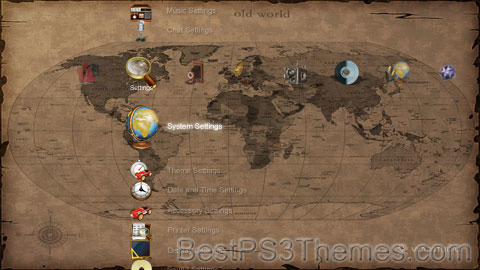
(2 backgrounds)
Iron Man Alternative
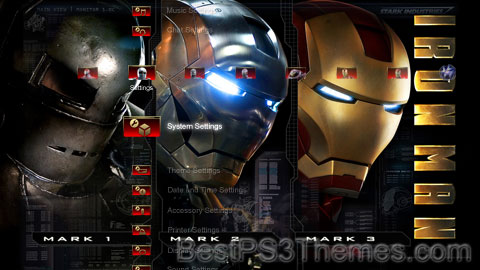
(6 backgrounds)
Copyright (c) 2007. Anoop Menon
p3textractor filename.p3t [destination path]Replace filename with the name of the p3t file, and replace [destination path] with the name of the folder you want the files to be extracted to. A destination path is not required. By default it will extract to extracted.filename.Iron Man Alternative (Standard Icons)
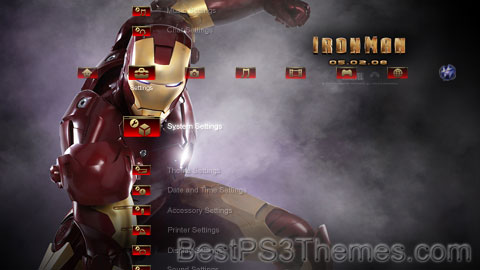
(6 backgrounds)
Copyright (c) 2007. Anoop Menon
p3textractor filename.p3t [destination path]Replace filename with the name of the p3t file, and replace [destination path] with the name of the folder you want the files to be extracted to. A destination path is not required. By default it will extract to extracted.filename.WinMac

(2 backgrounds)
Copyright (c) 2007. Anoop Menon
p3textractor filename.p3t [destination path]Replace filename with the name of the p3t file, and replace [destination path] with the name of the folder you want the files to be extracted to. A destination path is not required. By default it will extract to extracted.filename.Tux 2.0

(12 backgrounds)
Copyright (c) 2007. Anoop Menon
p3textractor filename.p3t [destination path]Replace filename with the name of the p3t file, and replace [destination path] with the name of the folder you want the files to be extracted to. A destination path is not required. By default it will extract to extracted.filename.2007 Shelby GT
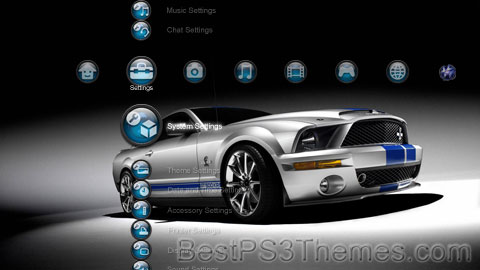
(1 background)
Copyright (c) 2007. Anoop Menon
p3textractor filename.p3t [destination path]Replace filename with the name of the p3t file, and replace [destination path] with the name of the folder you want the files to be extracted to. A destination path is not required. By default it will extract to extracted.filename.Aston Martin #2
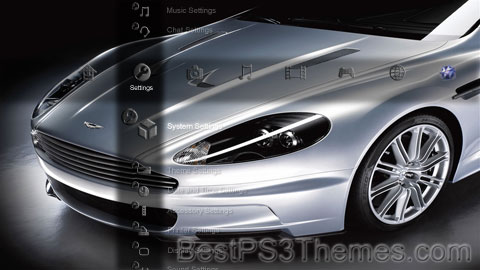
(1 background)
Global Holdings PLC
Company type Public limited company LSE: AML
FTSE 250 componentISIN GB00BFXZC448 ![]()
Industry Automotive Founded 15 January 1913 Founders Headquarters Gaydon, Warwickshire, England, United Kingdom Worldwide
(Executive chairman)
(chief executive officer)
(Chief Creative Officer)Products Brands Revenue ![]() £1,632.8 million (2023)[1]
£1,632.8 million (2023)[1]![]() –£79.7 million (2023)[1]
–£79.7 million (2023)[1]![]() –£226.8 million (2023)[1]
–£226.8 million (2023)[1]Subsidiaries Aston Martin Racing Website astonmartinlagonda.com History[edit]
Founding[edit]
1918–1939: Interwar years[edit]
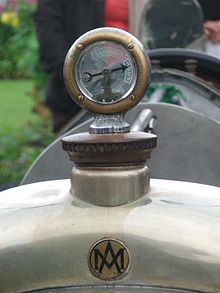

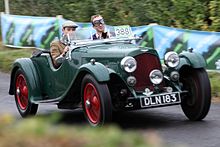
1947–1972: David Brown[edit]
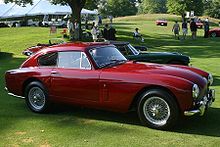
1972–1975: William Willson[edit]
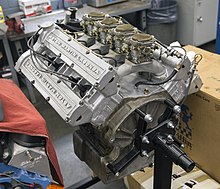
1975–1981: Sprague and Curtis[edit]
1981–1987: Victor Gauntlett[edit]

1987–2007: Ford Motor Company[edit]

2007–2018: Private Limited Company[edit]
Iron Man #3
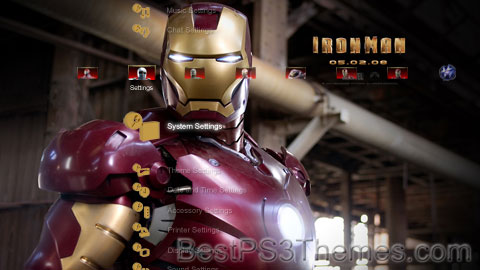
(6 backgrounds)
Tony Stark
Iron Man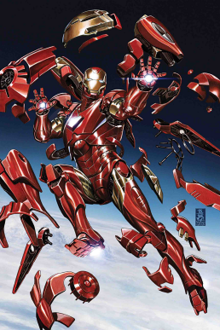
Publication information Publisher Marvel Comics First appearance Tales of Suspense #39
(December 1962)Created by In-story information Full name Anthony Edward Stark Place of origin Long Island, New York Team affiliations Partnerships Abilities
Publication history[edit]
Creation[edit]
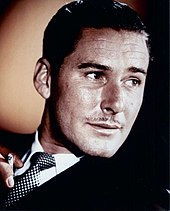
Early years[edit]
1970s[edit]
1980s and 1990s[edit]
2000s[edit]
2010s and 2020s[edit]

Characterization[edit]
Fictional character biography[edit]
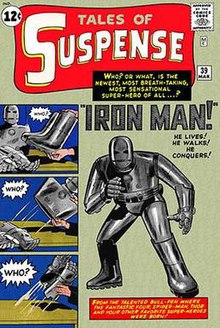
Iron Man (Standard Icons)
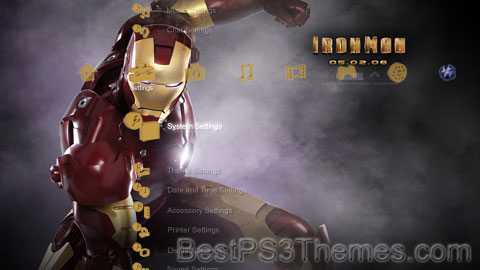
(6 backgrounds)
Copyright (c) 2007. Anoop Menon
p3textractor filename.p3t [destination path]Replace filename with the name of the p3t file, and replace [destination path] with the name of the folder you want the files to be extracted to. A destination path is not required. By default it will extract to extracted.filename.

